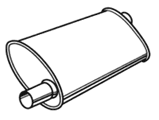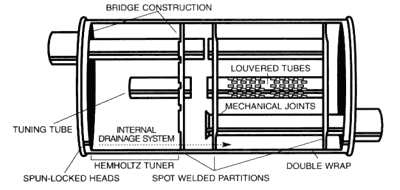
The first muffler was patented in 1897 by Marshall and Milton Reeves. The muffler is the main component of the exhaust system system for silencing acoustic exhaust noises. There are many different designs of mufflers available today. Some being chambered, glass pack, straight-thru glasspacks, and combinations of those. It is designed to reduce loudness and acoustic sound pressures created by the combustion process. Fiberglass is the most commonly used material inside of traditional mufflers. Other materials could include rock minerals, wool, fiber-mat, or simple metal chambers to aid in absorption and reduce unwanted exhaust sounds.
The location of a muffler varies depending on the vehicle make and model. The majority of mufflers are located toward the rear of the vehicle. Internal muffler designs (muffler chambers) are determined by the sound frequencies in need of control. The muffler can be made into many shapes, but round and oval are the two most commons shapes.
To do its job effectively, a muffler must be specifically designed for the vehicle it's paired with. Many factors determine the size, shape, and internal structure of the muffler. The internal design is specifically engineered for sound control only, and is rarely designed with performance in mind from the factory. Higher end sports car models will have mufflers more designed for performance versus exhaust noise suppression. After market exhaust companies will almost always be geared towards the performance aspect and offer and more throatier exhaust tone.
The internal design of the muffler can be a combination of chambers, partitions, louvered tubes, and solid tubes. It can also be a single type of design, most commonly called a "straight-thru" design. Straight thru designs are generally a glasspack design with a single, straight pipe running from inlet to outlet.
The amount, arrangement, and overall design of the tubes, chambers, and partitions used in a muffler depends upon the sound frequencies produced by the engine. Some chambers within the muffler have no outlet at all, while some have a small opening leading into another chamber. These are called Hemholtz tuners, and they reduce the low-pitched sound frequencies by deflecting the waves back into each other and cause a noise cancellation effect. Smaller chambers or pinch cans cancel the high pitched sound waves by channeling exhaust gas through their acoustic openings into larger chambers.
Performance muffler internal structures vary greatly between different vehicles because it will be "tuned" to that specific application. This provides the most effective way to gain performance while changing the shape of the exhaust sound. A point to note is the more the exhaust gases turn within the system, the higher the backpressure is created in the muffler. Therefore, the internal design of the muffler is critically important.
Outside the Muffler
Externally, a muffler must physically conform to the space restriction of the vehicle's under body. The overall size and shape of a muffler is determined available space. Proper design and physical placement is important because of the following reasons:
- Provides proper clearance to the vehicle under body.
- Avoids excessive heating of floor boards.
- Assures trouble-free installation.
- Assures proper clamping to prevent dangerous leaks.
- Eliminates strained hanger mounts.
Muffler Construction
A muffler must be able to withstand the running conditions of a vehicle. This includes the engine sound frequencies, hazardous driving conditions (off-roading), and most of all the muffler must withstand rust and corrosion. Some of the major causes of premature muffler failure are the following:
- Rupture from after fires (commonly mistaken as backfires)
- Internal corrosion from acidic condensate
- External corrosion from natural and artificial elements (i.e. - Salt Water & Road Salt)
- Poor and Improper exhaust system support (i.e. - rusted and broken hangers)

To protect against after fire ruptures, the muffler heads are spun-locked to the shell to provide the strongest resistance to this scenario. The inner shell and outer cover are also installed 180 degrees apart with a mechanical lock seam. The spun-locked heads and shell lock seam also ensure a gas-tight fit between the head and shell.
As exhaust gases pass through the catalytic converter, one of the chemical reaction by products is water. The muffler has a series of pin holes in the bottom to allow this water to escape. If these holes become plugged up, and water cannot escape or be evaporated quickly enough, the muffler will start to rust from the inside out. Do not drink this water, as it's not entirely pure! Generally, long distance highway and city driving will keep the mufflers hot enough to evaporate any water that is collected. Short distance driving, and low speed stop-and-go driving can cause a build up of excessive water within the system. It is nothing to fear, or to get worried about however.
- Louvered Tubes - These tubes provide better gas flow to maintain a more uniform internal temperature. By avoiding cool spots within the muffler, most acid condensation can be prevented.
- Internal Drainage System - A complete internal drainage system prevents most water from collecting within the muffler. The exits can be seen on the bottom of the muffler, or near the outlet tube.
- Spot Welded Partitions - Spot welding is used to attach the partitions to the muffler shell. The idea behind this is to keep strength, but also allow small amounts of space for exhaust water to be able to escape through in order to drain out.
- Mechanically Joined Internal Tubes - To ensure longer life, internal tubes are mechanically joined to the partition to allow free-floating expansion and contraction during temperature changes. This unique design eliminates the breaking of spot welds and subsequent part distortion or loose part noise problems.
RESONATOR

The resonator is a second silencing element that is used on some vehicles that have under body space limitations. When a muffler required to eliminate exhaust noise is too large to easily fit under the vehicle; two smaller silencing elements will then be used. The resonator serves to level out any loudness or roughness, which is not adequately handled by the undersized muffler.











